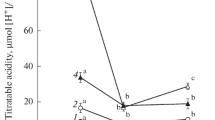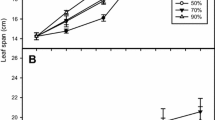Abstract
After being acclimated to constant warm (28°C day/28°C night) and cool-night temperature (28°C day/20°C night) regimes in growth chambers for 2 weeks, the two groups of mature Phalaenopsis aphrodite subsp. formosana plants both clearly exhibited a diurnal oscillation of stomatal conductance, net CO2 uptake rate, malate and starch levels, and the phosphoenolpyruvate carboxylase (EC 4.1.1.31) and NAD+-malic enzyme (EC 1.1.1.39) activities. Hence, P. aphrodite is an obligate crassulacean acid metabolism plant. Nevertheless, different night temperature greatly affected both the stomatal conductance and the contribution of ambient and respiratory CO2 to the nocturnal accumulation of malate. However, the amounts of nocturnal accumulated malate and daily deposited starch appeared to have no significant difference between the two groups. These results demonstrate that P. ahrodite is congruent with the characteristics of CAM plants having great flexibility and plasticity in response to changes in environmental conditions. In addition, the formation of reproductive stem, viz. spike, was noticeably inhibited by a constant warm temperature, but induced by a fluctuating warm day and cool night condition. The relationship between the metabolic pool variation and spike induction of Phalaenopsis is also discussed.





Similar content being viewed by others
Abbreviations
- CAM:
-
Crassulacean acid metabolism
- NAD(P)+-ME:
-
NAD(P)+-malic enzyme
- PEPCase:
-
Phosphoenolpyruvate carboxylase
References
Ali MB, Hahn EJ, Paek KY (2005) Effects of temperature on oxidative stress defense systems, lipid peroxidation and lipidoxygenase activity in Phalaenopsis. Plant Physiol Biochem 43:213–223
Arron GP, Spalting MH, Edwards GE (1979) Isolation and oxidative properties of intact mitochondria from the leaves of Sedum praealtum, a crassulacean acid metabolism plant. Plant Physiol 64:182–186
Bakrim N, Brulfert J, Vidal J, Chollet R (2001) Phosphoenolpyruvate carboxylase kinase is controlled by a similar signaling cascade in CAM and C4 plants. Biochem Biophys Res Com 286:1158–1162
Bernier G, Havelange A, Houssa C, Petitjean A, Lejeune P (1993) Physiological signals that induce flowering. Plant Cell 5:1147–1155
Blanchard MG, Runkle ES (2006) Temperature during the day, but not during the night, controls flowering of Phalaenopsis orchids. J Exp Bot 57:4043–4049
Borland AM, Griffiths H (1997) A comparative study on the regulation of C3 and C4 carboxylation processes in the constitutive crassulacean acid metabolism (CAM) plant Kalanchoë daigremontiana and C3-CAM intermediate Clusia minor. Planta 201:363–378
Buchanan-Bollig IC, Kluge M, Müller D (1984) Kinetic changes with temperature of phosphoenolpyruvate carboxylase from a CAM plant. Plant Cell Environ 7:63–70
Callaway TR, Martin SA, Wampler JL, Hill NS, Hill GM (1997) Malate content of forage varieties commonly fed to cattle. J Dairy Sci 80:1651–1655
Carter P, Wilkins MB, Nimmo HG, Fewson CA (1995) Effects of temperature on the activity of phosphoenolpyruvate carboxylsae and on the control of CO2 fixation in Bryophyllum fedtschenkoi. Planta 196:375–380
Chen LS, Lin Q, Nose A (2002) A comparative study on durnal changes in metabolite levels in the leaves of three crassulacean acid metabolism (CAM) species, Ananas comosus, Kalanchoë daigremontiana and K. pinnata. J Exp Bot 53:341–350
Christopher JT, Holtum JAM (1998) Carbohydrate partitioning in the leaves of Bromeliaceae performing C3 photosynthesis or crassulacean acid metabolism. Aust J Plant Physiol 25:371–376
Conti S, Smirnoff N (1994) Rapid triggering of malate accumulation in the C3/CAM intermediate plant Sedum telephium: relationship with water status and phosphoenolpyruvate carboxylase. J Exp Bot 45:1613–1621
Day DA (1980) Malate decarboxylation by Kalanchoë daigremontiana mitochondria and its role in crassulacean acid metabolism. Plant Physiol 65:675–679
Dittrich P (1976) Nicotinamide adenine dinucleotide-specific “malic” enzyme in Kalanchoë daigremontiana and other plants exhibiting crassulacean acid metabolism. Plant Physiol 57:310–314
Dodd AN, Borland AM, Haslam RP, Griffiths H, Maxwell K (2002) Crassulacean acid metabolism: plastic, fantastic. J Exp Bot 53:569–580
Endo M, Ikusima I (1989) Diurnal rhythm and characteristics of photosynthesis and respiration in the leaf and root of a Phalaenopsis plant. Plant Cell Physiol 30:43–47
Franco AC, Ball E, Lüttge U (1990) Patterns of gas exchange and organic acid oscillations in tropical trees of the genus Clusia. Oecologia 85:108–114
Gibson SI (2005) Control of plant development and gene expression by sugar signaling. Cur Opin Plant Biol 8:93–102
Griffiths H (1988) Crassulacean acid metabolism a re-appraisal of physiological plasticity in form and function. Adv Bot Res 15:43–92
Guo WJ, Lee N (2006) Effect of leaf and plant age and day/night temperature on net CO2 uptake in Phalaenopsis amabilis var. Formosa. J Amer Soc Hort Sci 131:320–326
Haag-Kerwer A, Franco AC, Luttge U (1992) The effect of temperature and light on gas exchange and acid accumulation in the C3-CAM plant Clusia minor L. J Exp Bot 43:345–352
Herppich M, Willert DJV, Herppich WB (1995) Diurnal rhythm in citric acid content-preceded onset of nighttime malic acid accumulation during metabolic changes from C3 to CAM in salt-stressed plants of Mesembryanthemum crystallinum. J Plant Physiol 147:38–42
Kano A (2001) Analysis of optimal temperature of Phalaenopsis based on a parameter derived from photosynthesis and growth. J Japan Soc Hort Sci 70:148
Kataoka K, Sumitomo K, Fudano T, Kawase K (2004) Changes in sugar content of Phalaenopsis leaves before floral transition. Sci Hortic 102:121–132
Lee N, Lee CH (1996) Changes in carbohydrates in Phalaenopsis during flower induction and inflorescence development. J Chin Soc Hort Sci 42:262–275
Lee N, Lin GM (1984) Effect of temperature on growth and flowering of Phalaenopsis white hybrid. J Chin Soc Hortic Sci 30:223–231
Lootens P, Heursel J (1998) Irradiance, temperature, and carbon dioxide enrichment affect photosynthesis in Phalaenopsis hybrids. HortSci 33:1183–1185
Lüttge U (1988) Day-night changes of citric-acid levels in crassulaceaen acid metabolism: phenomenon and ecophysiological significance. Plant Cell Environ 11:445–451
Lüttge U (1990) Nocturnal citrate accumulation and its response to environmental stress in the CAM plant Kalanchoë pinnata (Lam.) Pers. Plant Cell Environ 13:977–982
Lüttge U (2004) Ecophysiology of Crassulaceaen acid metabolism. Ann Bot 93:629–652
Lüttge U, Beck F (1992) Endogenous rhythms and chaos in crassulacean acid metabolism. Planta 188:28–38
Mattos EA, Lüttge U (2001) Chlorophyll fluorescence and organic acid oscillations during transition from CAM to C3-photosynthesis in Clusia minor L. (Clusiaceae). Ann Bot 88:457–463
McWilliams EL (1970) Comparative rates of dark CO2 uptake and acidification in Bromeliaceae, Orchidaceae, and Euphorbiaceae. Bot gaz 131:285–290
Medina E, Popp M, Olivares E, Janett HP, Lüttge U (1993) Daily fluctuations of titratable acidity, content of organic acids (malate and citrate) and soluble sugars of varieties and wild relatives of Ananas comosus L growing under natural tropical conditions. Plant Cell Environ 16:55–63
Medina E, Ziegler H, Lüttge U, Trimborn P, Francisco M (1994) Light conditions during growth revealed by δ13C values of leaves of primitive varieties of Ananas comosus, an obligate CAM species. Funct Ecol 8:298–305
Neales TF (1973) Effect of night temperature on the assimilation of carbon dioxide by mature pineapple plants, ANANAS COMOSUS (L.) MERR. Aust J Biol Sci 26:539–546
Nimmo HG (2000) The regulation of phosphenolpyruvate carboxylase in CAM plants. Trends Plant Sci 5:75–80
Nishida K (1978) Effect of leaf age on light and dark 14CO2 fixation in a CAM plant, Bryophyllum calycinum. Plant Cell Physiol 19:935–941
Nobel PS, Hartsock TL (1984) Physiological responses of Opuntia ficus-indica to growth temperature. Plant Physiol 60:98–105
Ohto MA, Onai K, Furukawa Y, Aoki E, Araki T, Nakamura K (2001) Effects of sugar on vegetative development and floral transition in Arabidopsis. Plant Physiol 127:252–261
Osmond CB (1978) Crassulacean acid metabolism: a curiosity in context. Annu Rev Plant Physiol 29:379–414
Ota K, Morioka K, Yamamoto Y (1991) Effects of leaf age, inflorescence, temperature, light intensity and moisture conditions on CAM photosynthesis in Phalaenopsis. J Japan Soc Hort Sci 60:125–132
Popp M, Janett HP, Lüttge U, Medina E (2003) Metabolite gradients and carbohydrate translocation in rosette leaves of CAM and C3 bromeliads. New Phytol 157:649–656
Pyankov VI, Voznesenskaya EV, Kuz’min AN, Ku MSB, Ganko E, Franceschi VR, Black CC, Edwards GE (2000) Occurrence of C3 and C4 photosynthesis in cotyledons and leaves of Salsola species (chenopodiaceae). Photosynth Res 63:69–84
Rohacek K, Bartak M (1999) Technique of the modulated chlorophyll fluorescence: basic concepts, useful parameters, and some applications. Photosynthetica 37:339–363
Roldán M, Gómez-Mena C, Ruiz-García L, Salinas J, Martínez-Zappater JM (1999) Sucrose availability on the aerial part of the plant promotes morphogenesis and flowering of Arabidopsis in the dark. Plant J 20:581–590
Rolland F, Baena-Gonzalez E, Sheen J (2006) Sugar sensing and signaling in plants: conserved and novel mechanisms. Annu Rev Plant Biol 57:675–709
Sakanishi Y, Imanishi H, Ishida G (1980) Effect of temperature on growth and flowering of phalaenopsi amabilis. Bull Univ Osaka Prefect Ser B 32:1–9
Wang YT (2007) Average daily temperature and reversed day/night temperature regulate vegetative and reproductive responses of a Doritis pulcherrima Lindley hybrid. HortSci 42:68–70
Wang HL, Lee PD, Juang RH, Su JC (1993) Starch accumulating sweet potato callus tissue devoid of β-amylase but with two starch phosphorylase isozymes. Biosci Biotech Biochem 57:1311–1315
Wang HL, Lee PD, Chen WL, Huang DJ, Su JC (2000) Osmotic stress-induced changes of sucrose metabolism in cultured sweet potato cells. J Exp Bot 51:1991–1999
Winter K, Schröppel-Meier G, Caldwell MM (1985) Respiratory CO2 as carbon source for nocturnal acid synthesis at high temperatures in three species exhibiting Crassulaceaen acid metabolism. Plant Physiol 81:390–394
Yoneda K, Momose H, Kubota S (1991) Effects of daylength and temperature on flowering in juvenile and adult Phalaenopsis plants. J Jpn Soc Hort Sci 60:651–657
Acknowledgments
We sincerely thank Taiwan Sugar Research Institute for lending the LI-6400 (Li-Cor Inc., Lincoln NE, USA) and Professor Yau-Lun Kuo (Graduate Institute of Bioresources, National Pingtung University of Science and Technology) for providing a light emitting diode source (6400-02, Li-Cor Inc., Lincoln NE, USA) for gas exchange measurements. This work was supported by the grants 93AS-1.1.2-FD-Z3, 94AS-1.3.2-FD-Z3, and 95AS-1.3.2-FD-Z3 from the Council of Agriculture, Executive Yuan, Taiwan.
Author information
Authors and Affiliations
Corresponding author
Additional information
Communicated by W.-H. Wu.
Rights and permissions
About this article
Cite this article
Chen, WH., Tseng, YC., Liu, YC. et al. Cool-night temperature induces spike emergence and affects photosynthetic efficiency and metabolizable carbohydrate and organic acid pools in Phalaenopsis aphrodite . Plant Cell Rep 27, 1667–1675 (2008). https://doi.org/10.1007/s00299-008-0591-0
Received:
Revised:
Accepted:
Published:
Issue Date:
DOI: https://doi.org/10.1007/s00299-008-0591-0




